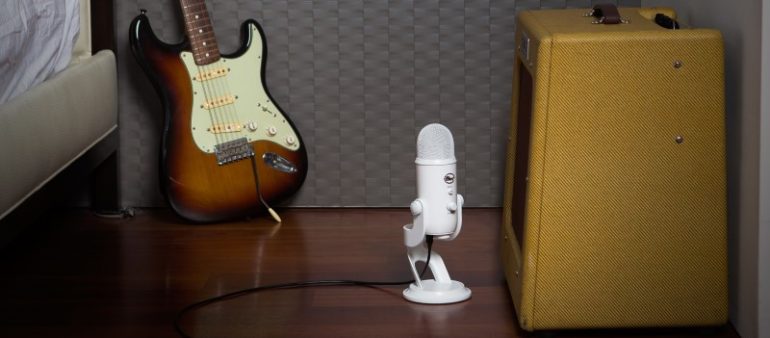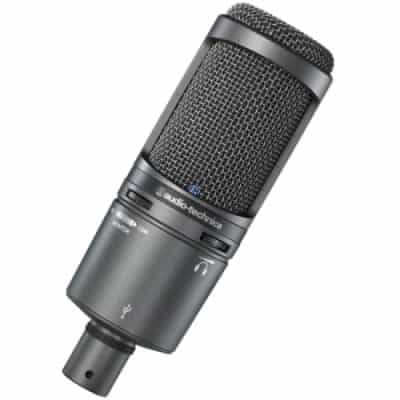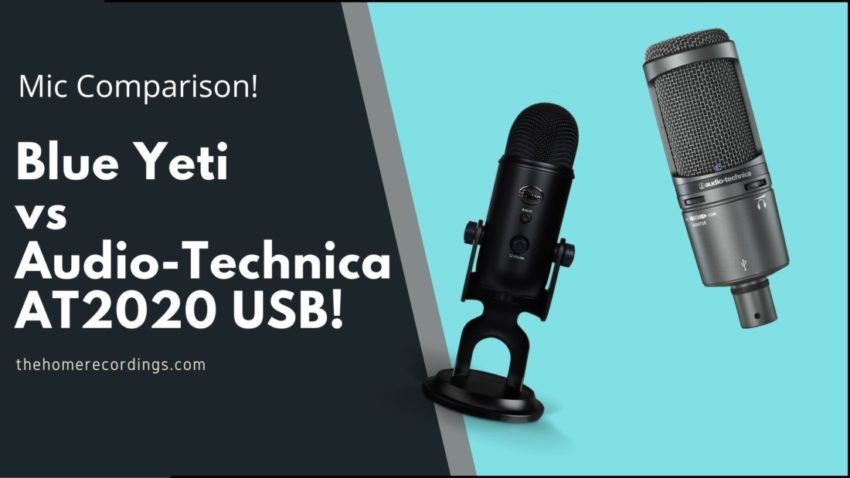Last updated on December 30th, 2023 at 02:53 pm
If you ever did a quick search on the internet about good USB microphones, then you probably got flooded with way too many results, and it’s understandable if you end up not knowing what to buy with so many different options.
I have a complete list of the best 12 USB microphones currently available which might be useful to you where I mention both the Blue Yeti and the Audio-Technica AT2020+ simply because they both are excellent microphones.
Now I will do my best to compare them both and give you an idea of which one you should go for depending on what you’re going to be using it for.
Main differences
The Blue Yeti has a darker sound, it is bigger and heavier and offers 4 different pickup patterns; Cardioid, Stereo, Omnidirectional and Bidirectional, while the AT2020 USB only offers a cardioid pickup pattern instead of multiple ones, while at the same time sounding brighter and crispier, and it’s also smaller and lighter.
Blue Yeti

Blue is known for making excellent quality, and cool-looking microphones which certainly aren’t as expensive as some others out there.
The Blue Yeti is their most famous microphone which works through USB and is plug n’ play, meaning that all you need to do is connect it and that’s it, it’s ready for use.
It will work perfectly both on Windows and Mac OS.
The build quality is great, it feels very durable and not like some cheap microphone.
It features a multitude of pickup patterns like cardioid, omnidirectional, stereo and bidirectional, which makes the Blue Yeti an incredibly versatile microphone, especially for the price range.
The cardioid pattern only picks up sound from the front, the omnidirectional pattern records in a 360-degree angle, the bidirectional pattern records only from the front and the back, while the stereo pattern records the sides separately, giving you a nice open sound.
To be honest, I only use the cardioid pattern and just sometimes switch over to the stereo one, but onmi and bidirectional aren’t really that useful to be honest, which is why I think that you shouldn’t focus too much on this specific feature of the mic since you too will most likely not be using them.
You can get it in four colors; Silver, Blackout, Whiteout and Cool Grey.
I think that it’s a great microphone for podcasters, YouTubers and Voice-over artists, but it’s also pretty good for recording music… emphasis on pretty good (more on this in a second).
This microphone also comes with a Gain control, mute button and a zero-latency headphone output, which is on the bottom of the mic and can sometimes be a bit annoying to deal with.
All the knobs are easy to use, and you can quickly tell how much- or how little gain you’re dialing in.
The reason the Blue Yeti is a good option for recording music is, apart from its great sound quality, that it can record in stereo, which is why I previously mentioned that it’s the only pattern I use apart from cardioid.
Why is the stereo pattern so useful?
We usually record acoustic guitars, pianos, etc. using two pencil condenser microphones which, when combined, give us a great-sounding stereo recording.
While the Blue Yeti won’t give you the exact same results as the two pencil microphones, it will certainly give you a better result than most cardioid microphones out there.
Another plus is that if you already own a cardioid microphone you can use the omni setting on the Blue Yeti and record with both of them at the same time, using the mid-side technique which is an excellent way of creating a stereo recording.
It’s worth noting, however, that it’s not that easy to record simultaneously with 2 USB microphones and you’ll have to check the internet for ways of doing this, but if you have one bidirectional mic and another cardioid mic, then you can definitely record with the mid/side technique and get some interesting results.
How does it Perform?
The Blue Yeti is very easy to use and doesn’t require any technical knowledge to be configured, just connect it and use it, without the need to worry about any drivers or latency issues.
The sound quality is very good considering the price, plus having four different pickup patterns, allows for a lot of versatility.
Need to record a bunch of people for a podcast? Or do you need to record and ensemble? Or maybe you just want it to have a conversation over skype…
With all of these pickup patterns you can easily do all of this without any issues.
However, and I really want to put some emphasis on this, omni and bidirectional patterns aren’t too useful if you’re someone who wants to record music or just create YouTube content. So, again, don’t think that the more pickup patterns the better, in fact, it’s usually the other way around since you want a microphone that does one thing exceptionally well and not many things in a mediocre way.
This is why I liked it especially for voice-related applications but not so much for recording music because even though the stereo pickup pattern can come in handy when recording something like an acoustic guitar, I just didn’t like the way it sounded as much; It doesn’t sound as bright as I would have hoped.
That’s why I said that it sounds “good” and not “great”.
Don’t get me wrong, it’s a fantastic microphone and it’s super worth the money, plus someone with an untrained ear won’t probably even notice these subtleties.
If you want a good microphone for a podcasting project or simply for making YouTube videos, then I think that you should choose the Blue Yeti, especially if you really are going to use the different pickup patterns, which most people won’t.
Another alternative would be the Rode NT USB, and I even did a comparison between it and the Blue Yeti. Make sure to check out that post.
What do you get in the Box?
- The Blue Yeti Microphone
- USB Cable
Features
- Tri-capsule array: three condenser capsules inside
- Multiple pattern selection: cardioid, stereo, omnidirectional and bidirectional
- Gain control, mute button, zero-latency headphone output
- Perfect for podcasting, voiceovers, game streaming, interviews, conference calls and music recording
- Plug ‘n play: Mac and PC compatible
- Desk stand included (already attached to the mic)
Specifications
- Polar Pattern; Cardioid, stereo, omni- and bidirectional
- Frequency Response: 20Hz- 20kHz
- Sample Rate: 48kHz/16-bit
- Max SPL: 120dB
- Weight: 1.2 lbs
If you’re looking for a versatile microphone, then it might be a good idea to go for the Blue Yeti.
Find out more about the Blue Yeti here:
- Blue Yeti: Amazon, Sweetwater.
Audio-Technica AT2020+ USB

There are few better-known brands in the music industry than Audio-Technica.
They make some of the best microphones on the market and the AT2020 is the go-to mic for almost every beginner home recording enthusiast, plus you won’t see a studio that doesn’t have at least a couple of them.
The USB version of the Audio-Technica AT2020 is just as good as the XLR AT2020 with the advantage of being a plug n’ play microphone which works both on Windows and Mac OS.
It comes with a built-in headphone jack with a volume control that allows you to directly monitor your microphone signal with no delay which is done via the mix control that blends the microphone signal with the signal coming from your PC.
The controls on the AT2020 aren’t as easy to use as the ones on the Blue Yeti since it’s harder to know exactly where you’re at with the dials, and also it doesn’t come with a Gain Knob, which doesn’t really make sense since you have to adjust that via software.
When setting the levels on the Blue Yeti you’ll find that it gives you a much more accurate representation of where you’re at, while with the AT2020+ you don’t really have an easy way of doing it; The gain has to be set via your PC’s sound settings, and all the other settings, such as headphone volume, don’t have a good indication of where you’re at.
One thing I do like about the AT2020 is that it’s a lot smaller and lighter than the Blue Yeti, which makes it a better microphone for travelling (The Blue Yeti is enormous).
Just like all the Audio-Technica microphones, the AT2020+ is extremely well built.
When holding it in my hand it doesn’t feel like a cheap product at all, quite the opposite in fact.
Just like the Blue Yeti, the AT2020 can be used for anything voice related, recording music, YouTube videos, etc. However, I prefer the AT2020 over the Blue Yeti. Remember I said that you want a microphone that doesn’t do a lot of things but rather one that does just one thing properly? Well, that’s the case with the AT2020.
It only has one cardioid polar pattern, but it sounds a lot better than the Blue Yeti.
How does it Perform?
Since the AT2020 is a plug n’ play microphone, you should have absolutely no issues getting it to work; simply connect it and that’s it, you can now record!
The sound quality is excellent, and I mean excellent, especially considering the price, since you probably won’t find another USB microphone at this price range that sounds like this.
The only thing I don’t like that much is that it can sound a bit crispy at times, but that isn’t that much of an issue really since you can fix that with just a bit of EQ afterwards.
The AT2020+ would be my top recommendation for anyone who is looking for a cardioid condenser USB microphone simply because of the sound quality.
Sure, the Blue Yeti might bring more versatility to the table, but if you’re only going to use the cardioid pattern, then I’d recommend the AT2020+ 100%.
It records your vocals extremely well, as well as acoustic and classical guitar, which is what I used it for before getting the AT3035 and the AT4040 (these are not USB mics and are much more expensive).
There’s a reason why the AT2020 is part of almost every music studio, and that is because when taking cost-effectiveness into account, there are few microphones that can stand up to it, and that’s also the case with the USB version.
What do you get in the Box?
- The Audio-Technica AT2020+ USB microphone
- Tripod desk stand
- USB cable
- Storage Pouch
Features
- Headphone Output with volume control
- Tripod desk stand and USB cable included
- Mac and PC Compatible
- Built-in headphone jack
- Mix and Volume Control
Specifications
- Polar Pattern: Cardioid
- Frequency Response: 20Hz- 20kHz
- Sample Rate: 44.1kHz – 48kHz/16-bit
- Weight: 386g
Find out more about the Audio-Technica AT2020 USB here.
- Audio-Technica AT2020+ USB: Amazon, Sweetwater.
Differences
The Blue Yeti sounds a bit darker, which is something that I don’t really like that much, plus the overall Audio Quality, when compared to the AT2020, isn’t as good.
The included desk stand is really good since it can swivel around and it comes with some padding on the bottom which should help reduce the vibration transmission generated by something like a keyboard.
Having all those extra pickup patterns is a definite plus for the Blue Yeti, even though I have to say that I like the AT2020+ way more mostly because we tend to use the cardioid pattern 99% of the time anyways, plus when compared side by side, the sound quality of the AT2020 comes out ahead, not by a lot, but it’s there.
Like I mentioned earlier, the AT2020 has some crisp to it which some of you might not like, but this can easily be fixed later with EQ.
Note: Both microphones will require a bit of post work to get them to sound how you really want them to, which really isn’t too bad since we all do some EQing, etc. after recording.
Essentially, get the AT2020+ most of the times unless you know you’re going to take advantage of the different polar patterns.
Conclusion
The clear winner, in my opinion, is the Audio-Technica AT2020+ for the simple fact that it sounds a bit better.
The difference isn’t really that big, both microphones will be more than enough especially if you’re doing some Podcasting or if you’re recording YouTube videos.
If you think that you’re going to need the extra pickup patterns, then go for the Blue Yeti.
If you normally just use the cardioid pattern, like most people do, go for the AT2020+.
I hope this information was useful!
Have a wonderful day!

which one good for asmr eating upload to youtube?
hey man, thanks a lot for the comparison. how does the noise floor compare between the two? i happened to buy a yeti just from the hype years ago, and i’ve had pretty good success with de-noising after the fact.
and i like that my voice actually sounds natural, rather than thin as through a phone.
but, sometimes, when the instrument i’m recording has strong components in the same freq range as the noise, they can end up sounding a bit dead after the processing. sometimes i have to turn the de-noise down to bring some of that back, but that’s obviously not great for multi-track.
if the AT2020 needs less noise reduction, i’d be interested to get it.
thanks again!
Many review the samson G track pro, what do you think of the mic comparing to the ones u review above?
Haven’t tried that one yet, probably going to order it at some point to try out!
Fantastic review, thank you very much !
do these microphones need a phantom power?
They are USB powered and the USB connection provides the power needed for them to work, you don’t need anything extra like an Interface or a dedicated phantom power supply.
Just connect them through USB to the PC and that’s it!
Hope this helps!